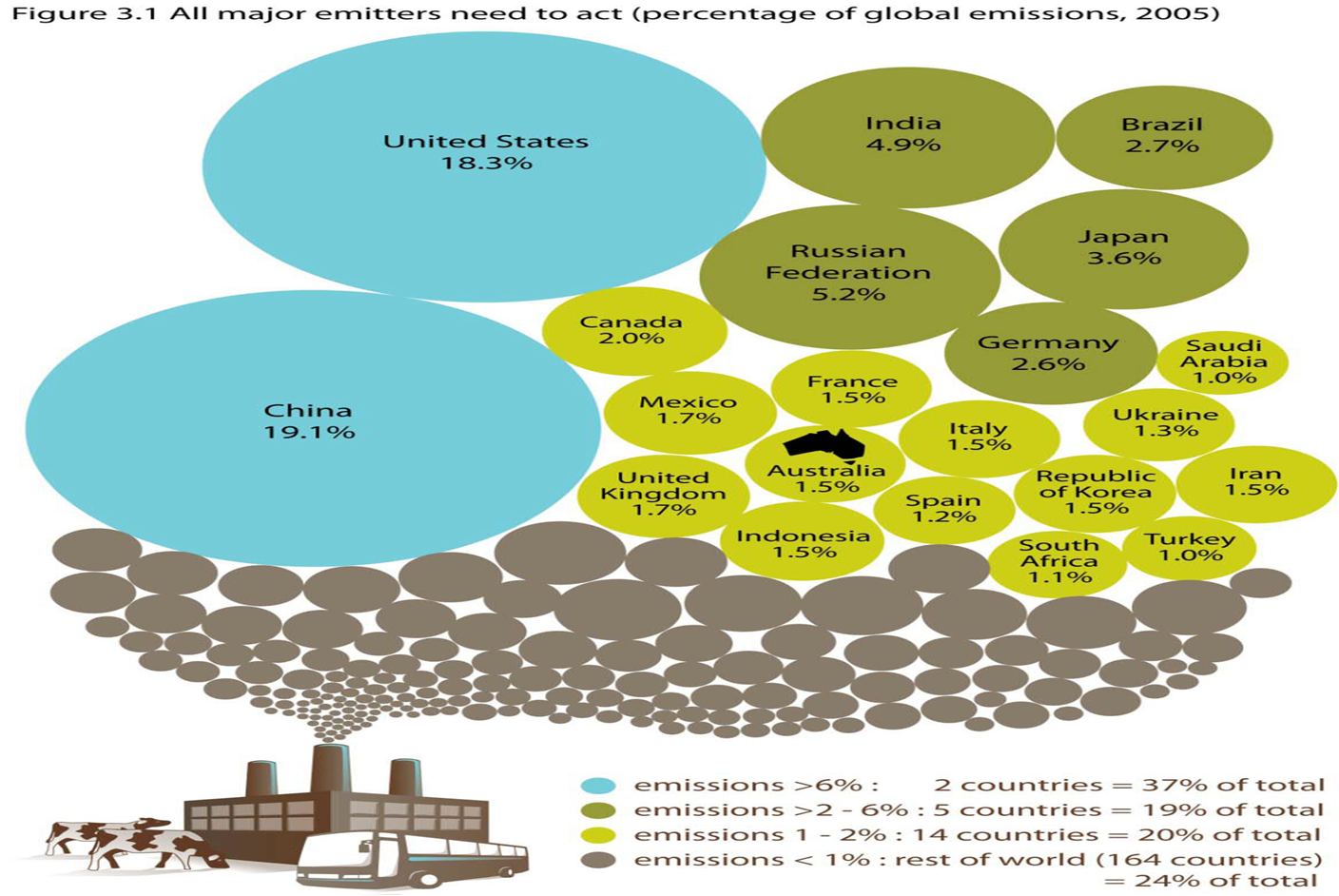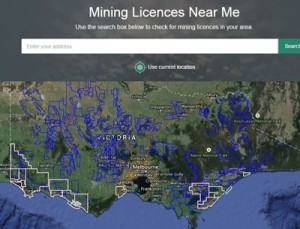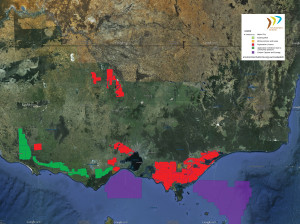What you will find on this page: LATEST NEWS; Fossil fuel emissions have stalled; Analysis: Record surge of clean energy in 2024 halts China’s CO2 rise; does the world need hydrogen?; Mapped: global coal trade; Complexity of energy systems (maps); Mapped: Germany’s energy sources (interactive access); Power to the people (video); Unburnable Carbon (report); Stern Commission Review; Garnaut reports; live generation data; fossil fuel subsidies; divestment; how to run a divestment campaign guide; local council divestment guide; US coal plant retirement; oil conventional & unconventional; CSG battle in Australia (videos); CSG battle in Victoria; leasing maps for Victoria; coal projects Victoria
Huge task to decarbonise
Source: Australian Delegation presentation to international forum held in Bonn in May 2012
Latest News 21 April 2025, Renew Economy: Taylor’s nuclear spin is an intense form of greenwashing from a party hellbent on fossil fuels. We’re deep into what’s been described as “debate season”, and for a political party that began this election campaign on shaky ground, there are increasing signs of desperation and weirdness coming from the Coalition. Part of the party’s plan to keep coal and gas at their maximum levels over the coming decades has been offering a false, manufactured vision of nuclear power for the future. It’s an intense form of greenwashing and the important thing to remember is that the party that spent nine years not legalising nuclear power when they were in government will absolutely never, ever decide to do that if they were to win power again. Honestly, Labor is more likely to eventually legalise nuclear power than the Coalition is. The dynamic of fabricated promises was demonstrated perfectly on the ABC’s 730 program debate between shadow treasurer and former energy minister Angus Taylor, and Treasurer Jim Chalmers. Taylor has a long and amusing history of gaffes and mistakes in energy, and during this debate, he claimed: “We know that by building seven 2 gigawatt baseload generators which will deliver a return to shareholders, which will be the taxpayers – they’ll deliver a return – that’s how they’re paid for.” The Global Energy Monitor’s amazing nuclear power tracker lets us quickly check out how large nuclear power units tend to be, and we can see that they’re consistently smaller than two gigawatts: Read more here: 21 April 2025, Renew Economy: “Damaging, regressive policies:” Coalition scores 1/100 on climate and nature, Labor scrapes a pass. One election cycle after the federal Coalition was Australian tossed out of government following a voter backlash against inaction on climate and renewables, the Liberal National Party has scored just 1 point out of 100 for its policies supporting climate and renewables.The “woeful score” was awarded to the Coalition as part of the Australian Conservation Foundation’s election scorecard, described as an issue-based assessment of how closely parties and candidates align with the ACF’s own policy agenda for protecting nature and acting on climate.ACF CEO Kelly O’Shanassy says it’s the lowest mark the election scorecard has ever given the Coalition – even lower than the 4/100 awarded in 2019, the year Tony Abbott lost his “safe” Liberal seat of Warringah in a protest vote against his climate wrecking efforts while prime minister. “The Coalition’s woeful score reflects its damaging, regressive policies: climate wrecking gas, and expensive and risky nuclear energy over clean, affordable renewables, coupled with cuts to environment protection at the behest of the fossil fuel industry,” O’Shanassy said on Tuesday. O’Shanassy says the Coalition scored its single point for acknowledging concerns about details of the AUKUS nuclear submarine deal that could saddle Australia with high levels of nuclear waste from overseas. But that is it. “Australia would be a worse place to live under the Coalition’s policies,” she said. The scorecard is based on surveys of the major parties and independent candidates in key seats to determine where they stand on the 16 outcomes in ACF’s national agenda. Read more here: 12 April 2025, Reuters: White House aims to eliminate NOAA climate research in budget plan. The administration of President Donald Trump aims to eliminate the arm of the National Oceanic and Atmospheric Administration that oversees research on climate change and refocus the U.S. fisheries service to support energy development, according to a draft White House budget document seen by Reuters. The moves are part of a plan to downsize NOAA dramatically, slashing agency funding by around $1.67 billion, or 27%, according to the proposal. The Office of Oceanic and Atmospheric Research, known also as NOAA Research, would be closed under the proposal, along with $480 million in funding for regional climate data and information, agency research laboratories, and cooperative institutes, among other programs. NOAA, a division of the Department of Commerce, is a scientific agency that oversees weather and climate forecasts, monitors ocean and atmospheric conditions and manages the nation’s commercial fisheries. The Trump administration has fired hundreds of NOAA workers as part of its effort to slash government bureaucracy. “No final funding decisions have been made,” Alexandra McCandless, a spokesperson for the White House Office of Management and Budget, said in an email. Read more here. 4 April 2025, The Conversation: No, that’s not what a trade deficit means – and that’s not how you calculate other nations’ tariffs. On April 2, United States President Donald Trump unveiled a sweeping new “reciprocal tariff” regime he says will level the playing field in global trade – by treating other countries the way (he claims) they treat the US. First, Trump’s plan will impose a “baseline” 10% tariff on virtually all goods imported into the US, effective April 5. Then, from April 9, 57 countries will face higher “reciprocal tariffs”. These vary by country, according to a formula based on individual trade deficits. On face value, the new tariff regime might sound like a simple solution for fairness. If a particular country was taxing American imports with a 50% tariff, it might seem fair for the US to tax their imports at 50% as well. But appearances are deceiving. These new “reciprocal” tariffs ostensibly aim to eliminate the US trade deficit by making imports more expensive so that Americans buy less from abroad until imports equal exports. But the Trump administration hasn’t directly matched specific foreign tariffs. Instead, they’ve opted for a crude formula based on bilateral trade deficits between the US and each specific country. Those aren’t the same things. Trade deficits aren’t tariffs A country has a trade deficit when the total value of everything it imports from somewhere else exceeds the value of what it exports there. A trade surplus is the opposite. Trade deficits and surpluses – the balance of trade – can be calculated between specific countries, but also between one country and the rest of the world. Tariffs are different things altogether – taxes a country charges on imports when they cross the border, paid by the importer. Read more here. 30 April 2025. The Guardian: UN climate talks will be ‘uphill battle’ amid Trump rollbacks, says Cop30 chair. Tariffs and environmental cuts will make meeting challenging, says summit president André Corrêa do Lago. Crucial United Nations climate talks this year will be a “slightly uphill battle” due to economic turmoil and Donald Trump’s removal of the US from the effort to tackle global heating, the chair of the upcoming summit has admitted. Governments from around the world will gather in Belem, Brazil, in November for the Cop30 meeting, where they will be expected to announce new plans to deal with the climate crisis and slash greenhouse gas emissions. Very few countries have done so yet, however, and the world remains well off track to remain within agreed temperature limits designed to avert the worst consequences of climate breakdown. It is not clear what, if any, presence the US will have at the talks after Trump, who calls climate change “a giant hoax”, removed the world’s leading economic power from the Paris climate agreement and set about demolishing environmental regulations at home. A trade war triggered by Trump has also caused concerns over a global economic downturn, further distracting leaders from the task of cutting emissions. Read more here: 28 April 2025, The Hill: Trump’s disastrous first 100 days. As April ends, so do the first 100 days of Donald Trump’s second presidency. We who watch from the sidelines will conduct our obligatory analyses of how he and the country are doing. The analyses could fill several books, surely. Trump has been very busy following the Project 2025 playbook and Steve Bannon’s advice to “flood the zone” with so many initiatives that the nattering nabobs of negativism have no chance to analyze one questionable act before Trump performs a few more. Trump has done more in three months than any president in memory to gut government, put civil servants out of work, appoint incompetent people to the highest government positions, create economic turmoil, jeopardize America’s alliances, and undermine the rest of the world’s confidence in the U.S. While he pretends to liberate America from government interference in their lives, he uses the actual or fabricated powers of the presidency to modify the behaviors of individuals and institutions far beyond his administration. It’s a strategy designed to cow his critics and extort society’s institutions and governments into compliance with the rigid ideologies of the far right. At some point, Congress and the courts may find the courage to curtail Trump’s excesses. In the meantime, Trump is advancing one especially destructive strategy whose damages will be long-lasting, if not permanent. Read more here 21 April 2025, Renew Economy: Taylor’s nuclear spin is an intense form of greenwashing from a party hellbent on fossil fuels. We’re deep into what’s been described as “debate season”, and for a political party that began this election campaign on shaky ground, there are increasing signs of desperation and weirdness coming from the Coalition. Part of the party’s plan to keep coal and gas at their maximum levels over the coming decades has been offering a false, manufactured vision of nuclear power for the future. It’s an intense form of greenwashing and the important thing to remember is that the party that spent nine years not legalising nuclear power when they were in government will absolutely never, ever decide to do that if they were to win power again. Honestly, Labor is more likely to eventually legalise nuclear power than the Coalition is. The dynamic of fabricated promises was demonstrated perfectly on the ABC’s 730 program debate between shadow treasurer and former energy minister Angus Taylor, and Treasurer Jim Chalmers. Taylor has a long and amusing history of gaffes and mistakes in energy, and during this debate, he claimed: “We know that by building seven 2 gigawatt baseload generators which will deliver a return to shareholders, which will be the taxpayers – they’ll deliver a return – that’s how they’re paid for.” The Global Energy Monitor’s amazing nuclear power tracker lets us quickly check out how large nuclear power units tend to be, and we can see that they’re consistently smaller than two gigawatts: Read more here: 21 April 2025, Renew Economy: “Damaging, regressive policies:” Coalition scores 1/100 on climate and nature, Labor scrapes a pass. One election cycle after the federal Coalition was Australian tossed out of government following a voter backlash against inaction on climate and renewables, the Liberal National Party has scored just 1 point out of 100 for its policies supporting climate and renewables.The “woeful score” was awarded to the Coalition as part of the Australian Conservation Foundation’s election scorecard, described as an issue-based assessment of how closely parties and candidates align with the ACF’s own policy agenda for protecting nature and acting on climate.ACF CEO Kelly O’Shanassy says it’s the lowest mark the election scorecard has ever given the Coalition – even lower than the 4/100 awarded in 2019, the year Tony Abbott lost his “safe” Liberal seat of Warringah in a protest vote against his climate wrecking efforts while prime minister. “The Coalition’s woeful score reflects its damaging, regressive policies: climate wrecking gas, and expensive and risky nuclear energy over clean, affordable renewables, coupled with cuts to environment protection at the behest of the fossil fuel industry,” O’Shanassy said on Tuesday. O’Shanassy says the Coalition scored its single point for acknowledging concerns about details of the AUKUS nuclear submarine deal that could saddle Australia with high levels of nuclear waste from overseas. But that is it. “Australia would be a worse place to live under the Coalition’s policies,” she said. The scorecard is based on surveys of the major parties and independent candidates in key seats to determine where they stand on the 16 outcomes in ACF’s national agenda. Read more here: 8 May 2025, Renew Economy: Australian politics loses climate warrior as Greens leader Adam Bandt concedes “purple” defeat. The Australian Greens will start the process of appointing a new leader in the aftermath of a federal election that delivered the highest vote in the party’s history but ended up with the ousting of its leader, Adam Bandt, and two other MPs in close contests with Labor. In a statement on Thursday afternoon, Bandt conceded defeat in the seat of Melbourne, after 15 years as the federal member (he was the first Greens MP to be elected in the lower house) and five years as leader of the Greens. In a cruel twist to an election that delivered an unexpected majority to the returning Albanese government, the Greens obtained their highest vote in Melbourne, but One Nation and Liberal preferences directed to the Labor candidate, Sarah Witty, gave that party the win. “To win in Melbourne we needed to overcome Liberal, Labor and One Nation combined, and it’s an Everest we’ve climbed a few times now, but this time we fell just short,” Bandt said on Thursday. “We know about the Greens, the Teals, and now there’s the Purples. Mix red and blue together and you get purple. There are now a swathe of seats where Labor MPs owe their political life to the Liberals’ preferences, and the Greens are the real opposition to the two party system.” As a key member of the Greens team that supported the Gillard minority Labor government, Bandt pushed for world leading climate laws and has since campaigned to deliver billions of dollars to drive Australia’s shift to renewable energy.. Read more here 30 April 2025. The Guardian: UN climate talks will be ‘uphill battle’ amid Trump rollbacks, says Cop30 chair. Tariffs and environmental cuts will make meeting challenging, says summit president André Corrêa do Lago. Crucial United Nations climate talks this year will be a “slightly uphill battle” due to economic turmoil and Donald Trump’s removal of the US from the effort to tackle global heating, the chair of the upcoming summit has admitted. Governments from around the world will gather in Belem, Brazil, in November for the Cop30 meeting, where they will be expected to announce new plans to deal with the climate crisis and slash greenhouse gas emissions. Very few countries have done so yet, however, and the world remains well off track to remain within agreed temperature limits designed to avert the worst consequences of climate breakdown. It is not clear what, if any, presence the US will have at the talks after Trump, who calls climate change “a giant hoax”, removed the world’s leading economic power from the Paris climate agreement and set about demolishing environmental regulations at home. A trade war triggered by Trump has also caused concerns over a global economic downturn, further distracting leaders from the task of cutting emissions. Read more here: 29 April 2025, The Conversation: Tempted to turn on the aircon? Science says use fans until it’s 27°C. Many Australians struggle to keep themselves cool affordably and effectively, particularly with rising electricity prices. This is becoming a major health concern, especially for our most vulnerable people such as the elderly, pregnant women and people with cardiovascular diseases. Air conditioning is often seen as the only solution to this problem. But relying too heavily on aircon has major downsides. These include hefty electricity bills, increased greenhouse gas emissions, strain on an already weak electricity grid, and dumping heat from buildings to the outside – further heating the outdoor air. Our latest research, published in the Medical Journal of Australia, highlights a simple yet effective solution: a “fan-first” cooling approach. The approach is simple: use electric fans as your first cooling strategy, and only turn on air conditioning when the indoor temperature exceeds 27°C. The solution: ‘fan-first’ cooling: Electric fans can make you feel more comfortable on a hot day simply by moving the air around you. This helps our body release heat in two ways: improving the transfer heat from your body into the air, and increasing the evaporation of sweat from your skin. A gentle breeze can make you feel up to 4°C cooler, even when the weather is very hot and humid. Read more here: 28 April 2025, The Hill: Trump’s disastrous first 100 days. As April ends, so do the first 100 days of Donald Trump’s second presidency. We who watch from the sidelines will conduct our obligatory analyses of how he and the country are doing. The analyses could fill several books, surely. Trump has been very busy following the Project 2025 playbook and Steve Bannon’s advice to “flood the zone” with so many initiatives that the nattering nabobs of negativism have no chance to analyze one questionable act before Trump performs a few more. Trump has done more in three months than any president in memory to gut government, put civil servants out of work, appoint incompetent people to the highest government positions, create economic turmoil, jeopardize America’s alliances, and undermine the rest of the world’s confidence in the U.S. While he pretends to liberate America from government interference in their lives, he uses the actual or fabricated powers of the presidency to modify the behaviors of individuals and institutions far beyond his administration. It’s a strategy designed to cow his critics and extort society’s institutions and governments into compliance with the rigid ideologies of the far right. At some point, Congress and the courts may find the courage to curtail Trump’s excesses. In the meantime, Trump is advancing one especially destructive strategy whose damages will be long-lasting, if not permanent. Read more here 27 January 2025, Carbon Brief: A record surge of clean energy kept China’s carbon dioxide (CO2) emissions below the previous year’s levels in the last 10 months of 2024. However, the new analysis for Carbon Brief, based on official figures and commercial data, shows the tail end of China’s rebound from zero-Covid in January and February, combined with abnormally high growth in energy demand, stopped CO2 emissions falling in 2024 overall. While China’s CO2 output in 2024 grew by an estimated 0.8% year-on-year, emissions were lower than in the 12 months to February 2024. Other key findings of the analysis include: As ever, the latest analysis shows that policy decisions made in 2025 will strongly affect China’s emissions trajectory in the coming years. In particular, both China’s new commitments under the Paris Agreement and the country’s next five-year plan are being prepared in 2025. Read More Here 3 November 2020, Carbon Brief: Hydrogen gas has long been recognised as an alternative to fossil fuels and a potentially valuable tool for tackling climate change. Now, as nations come forward with net-zero strategies to align with their international climate targets, hydrogen has once again risen up the agenda from Australia and the UK through to Germany and Japan. In the most optimistic outlooks, hydrogen could soon power trucks, planes and ships. It could heat homes, balance electricity grids and help heavy industry to make everything from steel to cement. But doing all these things with hydrogen would require staggering quantities of the fuel, which is only as clean as the methods used to produce it. Moreover, for every potentially transformative application of hydrogen, there are unique challenges that must be overcome. In this in-depth Q&A – which includes a range of infographics, maps and interactive charts, as well as the views of dozens of experts – Carbon Brief examines the big questions around the “hydrogen economy” and looks at the extent to which it could help the world avoid dangerous climate change. Access full article here Fossil fuel emissions have stalled 14 November 2016, The Conversation, Fossil fuel emissions have stalled: Global Carbon Budget 2016. For the third year in a row, global carbon dioxide emissions from fossil fuels and industry have barely grown, while the global economy has continued to grow strongly. This level of decoupling of carbon emissions from global economic growth is unprecedented.Global CO₂ emissions from the combustion of fossil fuels and industry (including cement production) were 36.3 billion tonnes in 2015, the same as in 2014, and are projected to rise by only 0.2% in 2016 to reach 36.4 billion tonnes. This is a remarkable departure from emissions growth rates of 2.3% for the previous decade, and more than 3% during the 2000’s. Read More here Do you want to understand the complexity of energy systems which support our high consumption lifestyles? Most people don’t give too much thought to where their electricity comes from. Flip a switch, and the lights go on. That’s all. The origins of that energy, or how it actually got into our homes, is generally hidden from view. This link will take you to 11 maps which explain energy in America (it is typical enough as an example of a similar lifestyle as Australia – when I find maps for Oz I’ll add them in) e.g. above map showing the coal plants in the US. Source: Vox Explainers Mapped: how Germany generates its electricity – another example Power to the People – Lock the Gate looks back at the wins of 2015 And there’s lots more coming up in 2016. Some of the big priorities coming up next for the “Lock the Gate” movement are: If you want to give “Lock the Gate” your support – go here for more info This new report reveals that the pollution from Australia’s coal resources, particularly the enormous Galilee coal basin, could take us two-thirds of the way to a two degree rise in global temperature. To Read More and download report The 2006 UK government commissioned Stern Commission Review on the Economics of Climate Change is still the best complete appraisal of global climate change economics. The review broke new ground on climate change assessment in a number of ways. It made headlines by concluding that avoiding global climate change catastrophe was almost beyond our grasp. It also found that the costs of ignoring global climate change could be as great as the Great Depression and the two World Wars combined. The review was (still is) in fact a very good assessment of global climate change, which inferred in 2006 that the situation was a global emergency. Read More here The Garnaut Climate Change Review was commissioned by the Commonwealth, state and territory governments in 2007 to conduct an independent study of the impacts of climate change on the Australian economy. Prof. Garnaut presented The Garnaut Climate Change Review: Final Report to the Australian Prime Minister, Premiers and Chief Ministers in September 2008 in which he examined how Australia was likely to be affected by climate change, and suggested policy responses. In November 2010, he was commissioned by the Australian Government to provide an update to the 2008 Review. In particular, he was asked to examine whether significant changes had occurred that would affect the analysis and recommendations from 2008. The final report was presented May 2011. Since then the Professor has regularly participated in the debate of fossil fuel reduction, as per his latest below: To access his reports; interviews; submissions go here 27 May 2015, Renew Economy, Garnaut: Cost of stranded assets already bigger than cost of climate action. This is one carbon budget that Australia has already blown. Economist and climate change advisor Professor Ross Garnaut has delivered a withering critique of Australia’s economic policies and investment patterns, saying the cost of misguided over-investment in the recent mining boom would likely outweigh the cost of climate action over the next few decades. Read More here Live generation of electricity by fuel type Fossil Fuel Subsidies – The Age of entitlement continues 24 June 2014, Renew Economy, Age of entitlement has not ended for fossil fuels: A new report from The Australia Institute exposes the massive scale of state government assistance, totalling $17.6 billion over a six-year period, not including significant Federal government support and subsidies. Queensland taxpayers are providing the greatest assistance by far with a total of $9.5 billion, followed by Western Australia at $6.2 billion. The table shows almost $18 billion dollars has been spent over the past 6 years by state governments, supporting some of Australia’s biggest, most profitable industries, which are sending most of the profits offshore. That’s $18 billion dollars that could have gone to vital public services such as hospitals, schools and emergency services. State governments are usually associated with the provision of essential services like health and education so it will shock taxpayers to learn of the massive scale of government handouts to the minerals and fossil fuel industries. This report shows that Australian taxpayers have been misled about the costs and benefits of this industry, which we can now see are grossly disproportionate. Each state provides millions of dollars’ worth of assistance to the mining industry every year, with the big mining states of Queensland and Western Australia routinely spending over one billion dollars in assistance annually. Read More here – access full report here What is fossil fuel divestment? Local Governments ready to divest Aligning Council Money With Council Values A Guide To Ensuring Council Money Isn’t Funding Climate Change. 350.org Australia – with the help of the incredible team at Earth Hour – has pulled together a simple 3-step guide for local governments interested in divestment. The movement to align council money with council values is constantly growing in Australia. It complements the existing work that councils are doing to shape a safe climate future. It can also help to reshape the funding practices of Australia’s fossil fuel funding banks. The steps are simple. The impact is huge.The guide can also be used by local groups who are interested in supporting their local government to divest as a step-by-step reference point. Access guide here How coal is staying in the ground in the US Sierra Club Beyond Coal Campaign May 2015, Politico, Michael Grunwald: The war on coal is not just political rhetoric, or a paranoid fantasy concocted by rapacious polluters. It’s real and it’s relentless. Over the past five years, it has killed a coal-fired power plant every 10 days. It has quietly transformed the U.S. electric grid and the global climate debate. The industry and its supporters use “war on coal” as shorthand for a ferocious assault by a hostile White House, but the real war on coal is not primarily an Obama war, or even a Washington war. It’s a guerrilla war. The front lines are not at the Environmental Protection Agency or the Supreme Court. If you want to see how the fossil fuel that once powered most of the country is being battered by enemy forces, you have to watch state and local hearings where utility commissions and other obscure governing bodies debate individual coal plants. You probably won’t find much drama. You’ll definitely find lawyers from the Sierra Club’s Beyond Coal campaign, the boots on the ground in the war on coal. Read More here Oil – conventional & unconventional May 2015, Oil change International Report: On the Edge: 1.6 Million Barrels per Day of Proposed Tar Sands Oil on Life Support. The Canadian tar sands is among the most carbon-intensive, highest-cost sources of oil in the world. Even prior to the precipitous drop in global oil prices late last year, three major projects were cancelled in the sector with companies unable to chart a profitable path forward. Since the collapse in global oil prices, the sector has been under pressure to make further cuts, leading to substantial budget cuts, job losses, and a much more bearish outlook on expansion projections in the coming years. Read full report here. For summary of report USA Sierra Club Beyond Oil Campaign Coal Seam Gas battle in Australia Lock the Gate Alliance is a national coalition of people from across Australia, including farmers, traditional custodians, conservationists and urban residents, who are uniting to protect our common heritage – our land, water and communities – from unsafe or inappropriate mining for coal seam gas and other fossil fuels. Read more about the missions and principles of Lock the Gate. Access more Lock the Gate videos here. Access Lock the Gate fact sheets here 2014: Parliament of Victoria Research Paper: Unconventional Gas: Coal Seam Gas, Shale Gas and Tight Gas: This Research Paper provides an introduction and overview of issues relevant to the development of unconventional gas – coal seam, shale and tight gas – in the Australian and specifically Victorian context. At present, the Victorian unconventional gas industry is at a very early stage. It is not yet known whether there is any coal seam gas or shale gas in Victoria and, if there is, whether it would be economically viable to extract it. A moratorium on fracking has been in place in Victoria since August 2012 while more information is gathered on potential environmental risks posed by the industry. The parts of Victoria with the highest potential for unconventional gas are the Gippsland and Otway basins. Notably, tight gas has been located near Seaspray in Gippsland but is not yet being produced. There is a high level of community concern in regard to the potential impact an unconventional gas industry could have on agriculture in the Gippsland and Otway regions. Industry proponents, however, assert that conventional gas resources are declining and Victoria’s unconventional gas resources need to be ascertained and developed. Read More here 28 January 2015, ABC News, Coal seam gas exploration: Victoria’s fracking ban to remain as Parliament probes regulations: A ban on coal seam gas (CSG) exploration will stay in place in Victoria until a parliamentary inquiry hands down its findings, the State Government has promised. There is a moratorium on the controversial mining technique, known as fracking, until the middle of 2015. The Napthine government conducted a review into CSG, headed by former Howard government minister Peter Reith, which recommended regulations around fracking be relaxed. Labor was critical of the review, claiming it failed to consult with farmers, environmental scientists and local communities. Read more here Keep up to date and how you can be involved here Friends of the Earth Melbourne Coal & Gas Free Victoria 20 May 2015, FoE, Inquiry into Unconventional Gas: Check here for details on the Victorian government’s Inquiry into unconventional gas. The public hearings have not yet started, however the Terms of Reference have been released. The state government’s promised Inquiry into Unconventional Gas has now been formally announced, with broad terms of reference (TOR). FoE’s response to the TOR is available here. The Upper House Environment and Planning Committee will manage the Inquiry. You can find the Inquiry website here. The final TOR will be determined by the committee. Significantly, it is a cross party committee. The Chair is a Liberal (David Davis), and there is one National (Melinda Bath), one Green (Samantha Dunn), three from the ALP (Gayle Tierney, Harriet Shing, Shaun Leane), an additional MP from the Liberals (Richard Dalla-Riva), and one MP from the Shooters Party (Daniel Young). Work started by the previous government, into water tables and the community consultation process run by the Primary Agency, will be released as part of the inquiry.The moratorium on unconventional gas exploration will stay in place until the inquiry delivers its findings. The interim report is due in September and the final report by December. There is the possibility that the committee will amend this timeline if they are overwhelmed with submissions or information. Parliament will then need to consider the recommendations of the committee and make a final decision about how to proceed. This is likely to happen when parliament resumes after the summer break, in early 2016. Quit Coal is a Melbourne-based collective that campaigns against the expansion of the coal and unconventional gas industries in Victoria. Quit Coal uses a range of tactics to tackle this problem. We advise the broader Victorian community about plans for new coal and unconventional gas projects, we put pressure on our government to stop investing in these projects, and we help to inform and mobilise Victorian communities so they can campaign on their own behalf. We focus on being strategic, creative, and as much as possible, fun! The above screen shot is of the Victorian State government’s Mining Licences Near Me site. Go to this link to see what is happening in your area Environment Victoria’s campaign CoalWatch is an interactive resource that tracks the coal industry’s expansion plans and helps builds a movement to stop these polluting developments. CoalWatch provides a way for everyday Victorians to keep track of the coal industry’s ambitious expansion plans. To check what tax-payer money has been pledged to brown coal projects and the coal projects industry is spruiking to our politicians. Here’s another map via EV website (go to their website and you should be able to get better detail from Google Maps: Red areas: Exploration licences (EL). These areas are held by companies to undertake exploration activity. A small bond is held by government in case of any damage. If a company wants to progress the project it needs to obtain a mining licence. Exploration Licence applications are marked with an asterix in the Places Index eg. EL4684*. Yellow areas: Mining Licences (MIN). A mining licence is granted with the expectation that mining will occur. A larger bond is paid to government. Green areas: Exploration licences that have been withdrawn or altered due to community concern. Green outline: Existing mines within Mining Licences. Purple areas: Geological Carbon Storage Exploration areas for carbon capture and storage. On-shore areas have been released by the State Government, while off-shore areas have been released by the Federal Government. The Coal Watch wiki tracks current and future Victorian coal projects, whether they are power stations, coal mines, proposals to export coal or some other inventive way of burning more coal. To get the full picture of coal in Victoria visit our wiki page. Get more info and see the full list of Exploration Licences current at 17 August 2012 here August 2015, Institute for Energy Economics & Financial Analysis – powerpoint: Changing Dynamics in the Global Seaborne Thermal Coal Markets and Stranded Asset Risk. Information from one of the slides follows. To view full presentation go here Economic Implications for Australia 83% of Australian coal mines are foreign owned, hence direct leverage of fossil fuels to the ASX is relatively small at 1-2%. However, for Australia the exposure is high, time is needed for transition and the new industry opportunities are significant: 1. Energy Infrastructure: Australia spends $5-10bn pa on electricity / grid sector, much of it a regulated asset base that all ratepayers fund much of it stranded. BNEF estimate of Australia’s renewable energy infrastructure investment for 2015-2020 was cut 30% from A$20bn post RET. Lost opportunities. 2. Direct employment: The ABS shows a fall of ~20k from the 2012 peak of 70K from coal mining across Australia, and cuts are ongoing. Indirect employment material. 3. Terms of trade: BZE estimates the collapse in the pricing of iron ore, coal and LNG cuts A$100bn pa from Australia’s export revenues by 2030, a halving relative to government budget estimates of 2013/14. Coal was 25% of NSW’s total A$ value of exports in 2013/14 (38% of Qld). Australia will be #1 globally in LNG by 2018. 4. The financial sector: is leveraged to mining and associated rail port infrastructure. WICET 80% financed by banks, mostly Australian. Adani’s Abbot Point Port is foreign owned, but A$1.2bn of Australian sourced debt. Insurance firms and infrastructure funds are leveraged to fossil fuels vs little RE infrastructure assets. BBY! 5. Rehabilitation: $18bn of unfunded coal mining rehabilitation across Australia. 6. Economic growth: curtailed as Australia fails to develop low carbon industries. Analysis: Record surge of clean energy in 2024 halts China’s CO2 rise
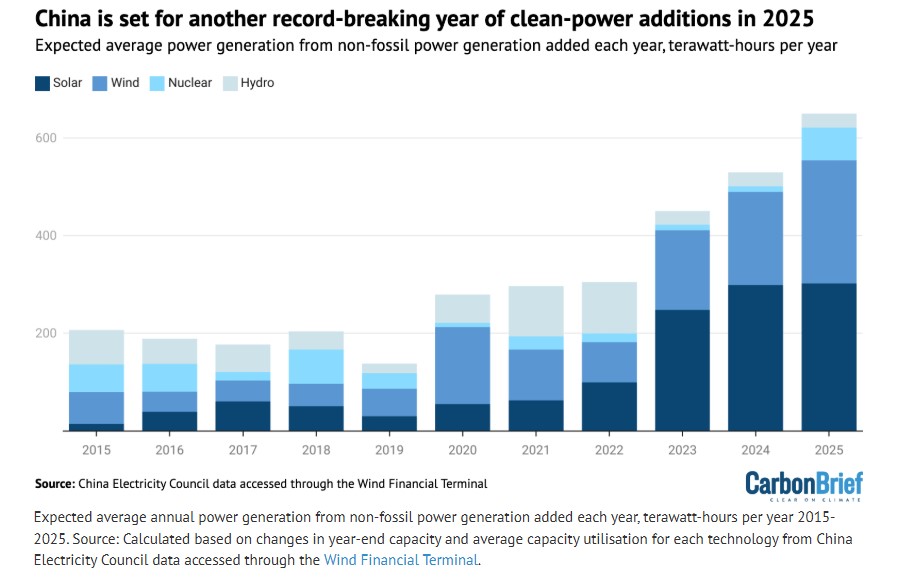
In-depth Q&A: Does the world need hydrogen to solve climate change?
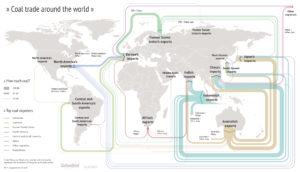 3 May 2016, Carbon Brief, The global coal trade doubled in the decade to 2012 as a coal-fueled boom took hold in Asia. Now, the coal trade seems to have stalled, or even gone into reverse. This change of fortune has devastated the coal mining industry, with Peabody – the world’s largest private coal-mining company – the latest of 50 US firms to file for bankruptcy. It could also be a turning point for the climate, with the continued burning of coal the biggest difference between business-as-usual emissions and avoiding dangerous climate change. Carbon Brief has produced a series of maps and interactive charts to show how the global coal trade is changing. As well as providing a global overview, we focus on a few key countries: Read More here
3 May 2016, Carbon Brief, The global coal trade doubled in the decade to 2012 as a coal-fueled boom took hold in Asia. Now, the coal trade seems to have stalled, or even gone into reverse. This change of fortune has devastated the coal mining industry, with Peabody – the world’s largest private coal-mining company – the latest of 50 US firms to file for bankruptcy. It could also be a turning point for the climate, with the continued burning of coal the biggest difference between business-as-usual emissions and avoiding dangerous climate change. Carbon Brief has produced a series of maps and interactive charts to show how the global coal trade is changing. As well as providing a global overview, we focus on a few key countries: Read More here/cdn0.vox-cdn.com/uploads/chorus_asset/file/3915730/EIA%20coal%20power%20plants.png)
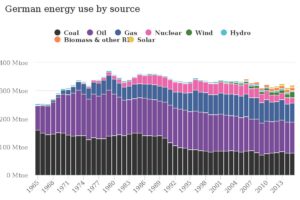
21 April 2015, Climate Council, Will Steffen: Unburnable Carbon: Why we need to leave fossil fuels in the ground.Stern Commission Review
Australia’s Garnaut Review
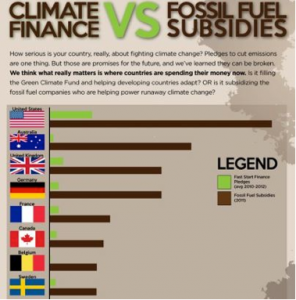 November 2014 – The Fossil Fuel Bailout: G20 subsidies for oil, gas and coal exploration report: Governments across the G20 countries are estimated to be spending $88 billion every year subsidising exploration for fossil fuels. Their exploration subsidies marry bad economics with potentially disastrous consequences for climate change. In effect, governments are propping up the development of oil, gas and coal reserves that cannot be exploited if the world is to avoid dangerous climate change. This report documents, for the first time, the scale and structure of fossil fuel exploration subsidies in the G20 countries. The evidence points to a publicly financed bailout for carbon-intensive companies, and support for uneconomic investments that could drive the planet far beyond the internationally agreed target of limiting global temperature increases to no more than 2ºC. It finds that, by providing subsidies for fossil fuel exploration, the G20 countries are creating a ‘triple-lose’ scenario. They are directing large volumes of finance into high-carbon assets that cannot be exploited without catastrophic climate effects. They are diverting investment from economic low-carbon alternatives such as solar, wind and hydro-power. And they are undermining the prospects for an ambitious climate deal in 2015. Access full report here For the summary on Australia’s susidisation of it’s fossil fuel industry go to page 51 of the report. The report said that the United States and Australia paid the highest level of national subsidies for exploration in the form of direct spending or tax breaks. Overall, G20 country spending on national subsidies was $23 billion. In Australia, this includes exploration funding for Geoscience Australia and tax deductions for mining and petroleum exploration. The report also classifies the Federal Government’s fuel rebate program for resources companies as a subsidy.
November 2014 – The Fossil Fuel Bailout: G20 subsidies for oil, gas and coal exploration report: Governments across the G20 countries are estimated to be spending $88 billion every year subsidising exploration for fossil fuels. Their exploration subsidies marry bad economics with potentially disastrous consequences for climate change. In effect, governments are propping up the development of oil, gas and coal reserves that cannot be exploited if the world is to avoid dangerous climate change. This report documents, for the first time, the scale and structure of fossil fuel exploration subsidies in the G20 countries. The evidence points to a publicly financed bailout for carbon-intensive companies, and support for uneconomic investments that could drive the planet far beyond the internationally agreed target of limiting global temperature increases to no more than 2ºC. It finds that, by providing subsidies for fossil fuel exploration, the G20 countries are creating a ‘triple-lose’ scenario. They are directing large volumes of finance into high-carbon assets that cannot be exploited without catastrophic climate effects. They are diverting investment from economic low-carbon alternatives such as solar, wind and hydro-power. And they are undermining the prospects for an ambitious climate deal in 2015. Access full report here For the summary on Australia’s susidisation of it’s fossil fuel industry go to page 51 of the report. The report said that the United States and Australia paid the highest level of national subsidies for exploration in the form of direct spending or tax breaks. Overall, G20 country spending on national subsidies was $23 billion. In Australia, this includes exploration funding for Geoscience Australia and tax deductions for mining and petroleum exploration. The report also classifies the Federal Government’s fuel rebate program for resources companies as a subsidy.

